
Eagle is the common name for the golden eagle, bald eagle, and other birds of prey in the family Accipitridae. Eagles belong to several groups of genera, some of which are closely related. True eagles comprise the genus Aquila. Most of the 68 species of eagles are from Eurasia and Africa. Outside this area, just 14 species can be found—two in North America, nine in Central and South America, and three in Australia.

Haast's eagle is an extinct species of eagle that lived in the South Island of New Zealand, commonly accepted to be the pouākai of Māori mythology. It is the largest eagle known to have existed, with an estimated weight of 15 kilograms, compared to the next-largest and extant harpy eagle, at up to 9 kg (20 lb). Its massive size is explained as an evolutionary response to the size of its prey—the flightless moa—the largest of which could weigh 230 kg (510 lb). Haast's eagle became extinct around 1445, following the arrival of the Māori, who hunted moa to extinction, introduced the Polynesian rat, and destroyed large tracts of forest by fire.

The Accipitridae is one of the three families within the order Accipitriformes, and is a family of small to large birds of prey with strongly hooked bills and variable morphology based on diet. They feed on a range of prey items from insects to medium-sized mammals, with a number feeding on carrion and a few feeding on fruit. The Accipitridae have a cosmopolitan distribution, being found on all the world's continents and a number of oceanic island groups. Some species are migratory. The family contains 255 species which are divided into 70 genera.

The wedge-tailed eagle is the largest bird of prey in the continent of Australia. It is also found in southern New Guinea to the north and is distributed as far south as the state of Tasmania. Adults of the species have long, broad wings, fully feathered legs, an unmistakable wedge-shaped tail, an elongated upper mandible, a strong beak and powerful feet. The wedge-tailed eagle is one of 12 species of large, predominantly dark-coloured booted eagles in the genus Aquila found worldwide. Genetic research has clearly indicated that the wedge-tailed eagle is fairly closely related to other, generally large members of the Aquila genus. A large brown-to-black bird of prey, it has a maximum reported wingspan of 2.84 m and a length of up to 1.06 m.
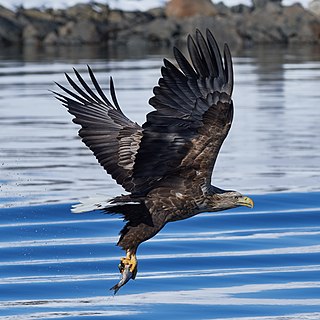
The white-tailed eagle, sometimes known as the 'sea eagle', is a large bird of prey, widely distributed across temperate Eurasia. Like all eagles, it is a member of the family Accipitridae which includes other diurnal raptors such as hawks, kites, and harriers. One of up to eleven members in the genus Haliaeetus, which are commonly called sea eagles, it is also referred to as the white-tailed sea-eagle. Sometimes, it is known as the ern or erne, gray sea eagle and Eurasian sea eagle.

The harpy eagle is a large neotropical species of eagle. It is also called the American harpy eagle to distinguish it from the Papuan eagle, which is sometimes known as the New Guinea harpy eagle or Papuan harpy eagle. It is the largest and most powerful bird of prey found throughout its range, and among the largest extant species of eagles in the world. It usually inhabits tropical lowland rainforests in the upper (emergent) canopy layer. Destruction of its natural habitat has caused it to vanish from many parts of its former range, and it is nearly extirpated from much of Central America. In Brazil, the harpy eagle is also known as royal-hawk. The genus Harpia, together with Harpyopsis, Macheiramphus and Morphnus, form the subfamily Harpiinae.
Aiolornis incredibilis is an extinct species of teratorn bird from the western United States. Only fragmentary remains have been found, which are dated between the Early Pliocene (Zanclean) and Late Pleistocene. First described as Teratornis incredibilis by Howard in 1952 based on a cuneiform bone, the species has been moved to the new genus Aiolornis by Campbell, Scott and Springer in 1999. The generic name is derived from the ancient Greek words aiolus and ornis. Aiolus refers to the Greek god of the wind, and ornis means "bird". The specific name incredibilis means ‘incredible’. A. incredibilis is lesser-known than its close relative, Teratornis merriami, even though A. incredibilis was significantly larger. It presumably became extinct at the same time as the other megafauna in North America.
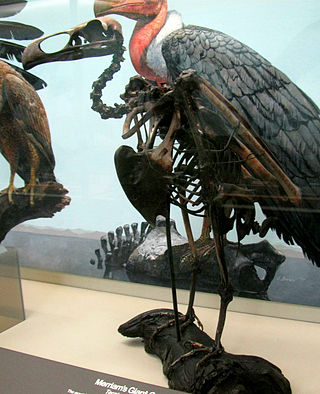
Teratornithidae is an extinct family of very large birds of prey that lived in North and South America from the Late Oligocene to Late Pleistocene. They include some of the largest known flying birds.
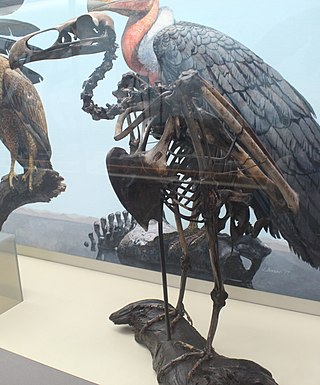
Teratornis was a genus of huge North American birds of prey—the best-known of the teratorns—of which, two species are known to have existed: Teratornis merriami and Teratornis woodburnensis. A large number of fossil and subfossil bones, representing more than 100 individuals, have been found in locations in California, Oregon, southern Nevada, Arizona, and Florida, though most are from the Californian La Brea Tar Pits. All remains except one Early Pleistocene partial skeleton from the Leisey Shell Pit near Charlotte Harbor, Florida date from the Late Pleistocene, with the youngest remains dating from the Pleistocene–Holocene boundary.

The little eagle is a very small eagle endemic to Australia.

Woodward's eagle is an extinct species of black hawk that lived in North America and the Caribbean during the Late Pleistocene. Remains have been found in the La Brea Tar Pits in the United States and in Cuba. Despite the common name, the species is technically a gigantic variety of hawk as it is a member of the still extant black hawk genus, Buteogallus, within the Buteoninae subfamily that are chiefly referred to as hawks, and not the Aquilinae subfamily most eagles belong to.
Titanohierax gloveralleni, also known as the Bahama eagle, is a large species of extinct hawk from the Late Quaternary of the Caribbean. Remains of the animal have been found on multiple islands in The Bahamas. The animal is known from a handful of bones found across multiple islands, including a tarsometatarsus, partial metacarpal, and nearly complete right ulna. The animal was described based on the former two by Alexander Wetmore in 1937, with all other currently referred material being assigned by Storrs Olson and colleagues in 1982.
Buteogallus daggetti, occasionally called "Daggett's eagle" or the "walking eagle", is an extinct species of long-legged hawk which lived in southwest North America during the Pleistocene. Initially believed to be some sort of carrion-eating eagle, it was for some time placed in the distinct genus Wetmoregyps, named for Alexander Wetmore. It probably resembled a larger version of the modern-day savanna hawk, with its long legs possibly used like the secretarybird of Africa to hunt for small reptiles from a safe distance. It died out about 13,000 years ago.
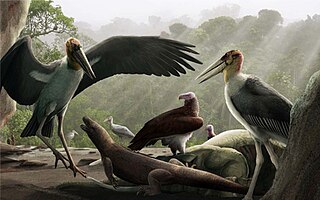
Leptoptilos robustus is an extinct species of large-bodied stork belonging to the genus Leptoptilos that lived on the island of Flores in Indonesia during the Pleistocene epoch. It stood at about 1.8 metres (5.9 ft) tall and weighed up to an estimated 16 kilograms (35 lb). The majority of the discoveries are concentrated in Liang Bua cave located slightly north of Ruteng in the East Nusa Tenggara province.

The Aquilinae are a subfamily of eagles of the family Accipitridae. The general common name used for members of this subfamily is "booted eagle", although this is also the common name of a member of the subfamily. At one point, this subfamily was considered inclusive with the Buteoninae based probably on some shared morphological characteristics. However, research on the DNA of the booted eagles has shown that they are a monophyletic group that probably have had millions of years of separation from other extant forms of accipitrid.
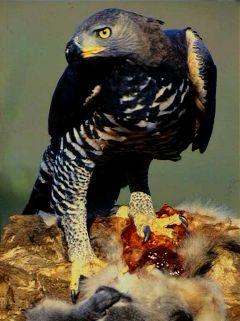
The crowned eagle, also known as the African crowned eagle or the crowned hawk-eagle, is a large bird of prey found in sub-Saharan Africa; in Southern Africa, it is restricted to more easterly areas. Its preferred habitats are principally riparian woodlands and various forests. The crowned eagle is the only extant member of the genus Stephanoaetus. A second species, the Malagasy crowned eagle, went extinct after early humans settled on Madagascar.
Gigantohierax is a genus of eagle from the Quaternary of present-day Cuba. Little is known about the two known species of the genus other than their very large size.
Giganhinga is a genus of giant darter that lived during the Late Miocene to Early Pleistocene in what is now Uruguay and Argentina. The largest species of anhinga known to science, estimates suggest it may have weighed around 17.7 kg (39 lb) and was likely flightless. Its weight likely helped it dive for prey and the anatomy of the pelvis indicates that it was a good and maneuverable swimmer. Only a single species is currently recognized, G. kiyuensis.
Cryptogyps is an extinct genus of Old World vulture from the Pleistocene of Australia. It was relatively small for a vulture but still larger than the extant wedge-tailed eagle. Originally described as an eagle in 1905, in 2022 it was reidentified as a vulture, the first known example from the continent. Phylogenetic analysis suggests it either being a sister species to the extant, widespread Eurasian vulture genus Gyps or as a more basal member of the subfamily. The identification of Cryptogyps as a vulture solves a longstanding mystery about the lack of specialized lineages of large scavenging birds in Australia despite being present on every other continent aside from Antarctica. It is likely that Cryptogyps went extinct towards the end of the Pleistocene due to the disappearance of the megafauna it depended on for carrion. The genus contains a single species, C. lacertosus.















